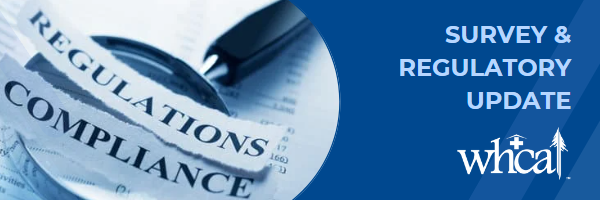Mar 21 2023 | Psychosocial Outcome Severity Guide and Citations at F600-Abuse
The Centers for Medicare & Medicaid Services (CMS) released the psychosocial outcome and severity guide (POSG) in conjunction with the Phase 2 ROP (Requirements of Participation) changes and Phase 3 ROP F-tags and guidance in QSO-22-19-NH. Before reviewing the relationship of the POSG to an abuse citation, it is important to revisit the purpose of the guide and how CMS directs the surveyors to implement it.
- The POSG helps surveyors determine the severity of psychosocial outcomes resulting from identified noncompliance at a specific F tag and how to apply the principles described in the POSG to cases of abuse at Tag F600 in Appendix PP. CMS emphasizes that surveyors must determine whether noncompliance exists first before determining the severity level of a deficiency.
- The POSG is used in conjunction with the scope and severity grid to determine the severity of outcomes to each resident. This guide is not intended to replace the current scope and severity grid.
- The POSG applies to any regulatory grouping, such as Quality of Life or Quality of Care, which results in, or may result in, a negative psychosocial outcome.
- Lastly, the POSG describes how to apply the “reasonable person concept,” when the impact on the resident may not be apparent or documented.
Reasonable person concept is to assist the survey team’s assessment of the severity level of negative or potential negative psychosocial outcome that a deficiency may have had on a reasonable person in the resident’s position.
The Psychosocial Outcome Severity Guide is not found in Appendix PP of the State Operations Manual (SOM), it is found in the CMS Nursing Home Survey Resource Folder.
CMS updated the POSG to provide information to surveyors about how to investigate psychosocial outcomes to the resident. Surveyors are to obtain evidence through observation, interview, and record review. Surveyors should collect information regarding the resident’s verbal and non-verbal responses. If a psychosocial outcome is identified, the surveyors are to compare the resident’s behavior (e.g., their routine, activity, and responses to staff or to everyday situations) and mood before and after the noncompliance, and any identified history of similar incidents.
When a surveyor cannot conduct an interview with the resident for any reason, or there are no apparent or documented changes to behavior, the surveyor should attempt to interview other individuals who are familiar with the resident’s routine or lifestyle, such as the resident’s representative, the resident’s family, Ombudsman, the resident’s direct care staff, and/or medical professionals, to assess the psychosocial impact on the resident.
If no changes are apparent or documented, the surveyor should consider the response a “reasonable person” would exhibit in light of the triggering event. CMS describes three instances in the guide in which a surveyor should use the reasonable persons concept:
- There are no apparent or documented changes to the resident’s behavior.
- When a resident may not be able to express their feelings, there is no discernable response, or when circumstances may not permit the direct evaluation of the resident’s psychosocial outcome.
- When a resident’s reaction is markedly different with the level of reaction a reasonable person in the resident’s position would have to the deficient practice.
When applying the reasonable person concept, the surveyor should consider the following in regard to the resident’s position (what degree of actual or potential harm would one expect a reasonable person in a similar situation to suffer as a result of non-compliance):
- The resident may consider the facility to be his/her “home,” where there is an expectation that s/he is safe, has privacy, and will be treated with respect and dignity.
- The resident trusts and relies on facility staff to meet his/her needs.
- The resident may be frail and vulnerable.
The surveyor should document evidence that describes the resident’s actual response and the perspectives of someone familiar with the resident. In applying the reasonable person concept, it may reveal that the resident is likely to, or may potentially, suffer a greater psychosocial harm. CMS examples such things as expressions of anger, agitation, or distress that has caused aggression that can be manifested by self‐directed responses, hitting, shoving, biting, or scratching others, crying, moaning, screaming, or combative behavior that is above the resident’s baseline, fear or anxiety that may be manifested as panic, immobilization, and/or agitated behaviors, such as trembling or cowering. Which may result in an Immediate Jeopardy determination.
CMS states that the psychosocial outcome of abuse may not be apparent at the time of the survey, since it may take months or years to manifest itself and can have long‐ term effects on the resident and his/her relationship with others.
Examples of abuse that create the likelihood for serious psychosocial harm, or immediate jeopardy to a resident include, but are not limited to:
- Sexual assault, such as rape, unwanted sexual touching, sexual harassment, and any staff to resident physical, sexual, or mental/verbal abuse.
- Posting/sharing of demeaning/humiliating photos/videos, punishment such as taking away resident’s things, withholding care, resident to resident physical abuse which is likely to cause fear/harm.
The survey team will document on the CMS-2567 when it applies the reasonable person concept in determining the psychosocial outcome(s) for a deficiency.
SNF Questions? Email Elena Madrid, or call at 1 (800) 562-6170, ext. 105.
Posted in Skilled Nursing Facilities, Survey & Regulatory

